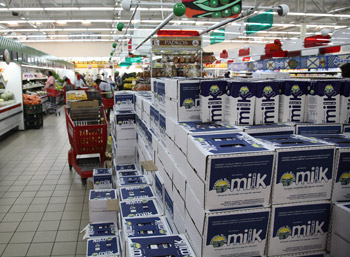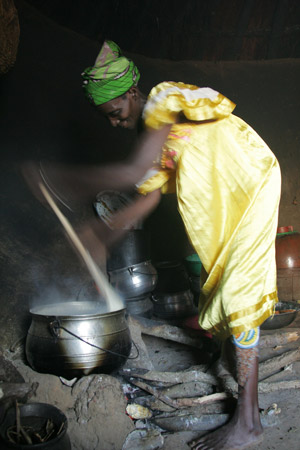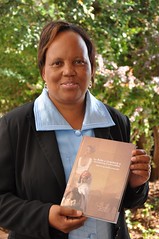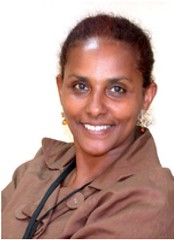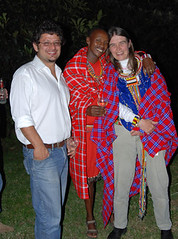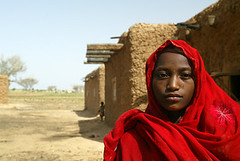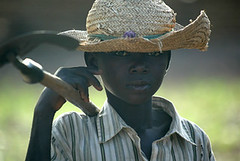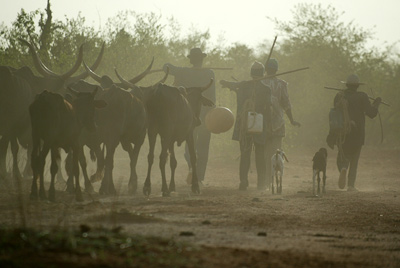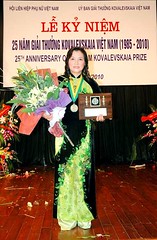 Prof Dr Le Thi Thuy, Director of the Department of Science and International Cooperation of Vietnam’s National Institute of Animal Husbandry, has been awarded the 2009 Kovalepskaia Award in recognition of her role as a woman scientist working on conservation of indigenous livestock breeds. The award is named after Sophia Kovalepskaia, an eminent 19th-century Russian mathematician. Thuy is serving as the national project director in Vietnam of a multi-national project scientists are leading at the International Livestock Research Institute (ILRI) to help conserve the indigenous farm animal genetic resources of Asia. This project is funded by the Global Environment Facility. The Alexander Von Humboldt Foundation of Germany bestows a bi-annual Sofia Kovalevskaya Award to promising young researchers from all fields. From Wikipedia: Sofia Kovalevskaya, 1850–1891, was the first major Russian female mathematician, responsible for important original contributions to analysis, differential equations and mechanics, and the first woman appointed to a full professorship in Northern Europe. Despite her obvious talent for mathematics, she could not complete her education in Russia. At that time, women there were not allowed to attend the universities. To study abroad, she needed written permission from her father (or husband). Accordingly, she contracted a "fictitious marriage" with Vladimir Kovalevsky, then a young paleontology student who would later become famous for his collaborations with Charles Darwin. They emigrated from Russia in 1867. In 1869, Kovalevskaya began attending the University of Heidelberg, Germany, which allowed her to audit classes as long as the professors involved gave their approval. Shortly after beginning her studies there, she visited London with Vladimir, who spent time with his colleagues Thomas Huxley and Charles Darwin, while she was invited to attend George Eliot's Sunday salons. There, at age nineteen, she met Herbert Spencer and was led into a debate, at Eliot's instigation, on ‘woman's capacity for abstract thought’. This was well before she made her notable contribution of the ‘Kovalevsky top’ to the brief list of known examples of integrable rigid body motion. After two years of mathematical studies at Heidelberg, she moved to Berlin, where she had to take private lessons, as the university would not even allow her to audit classes. In 1874 she presented three papers—on partial differential equations, on the dynamics of Saturn's rings and on elliptic integrals—to the University of Göttingen as her doctoral dissertation. This earned her a doctorate in mathematics summa cum laude, bypassing the usual required lectures and examinations. She thereby became the first woman in Europe to hold that degree. Her paper on partial differential equations contains what is now commonly known as the Cauchy-Kovalevski theorem, which gives conditions for the existence of solutions to a certain class of those equations. In 1889 she was appointed Professorial Chair holder at Stockholm University, the first woman to hold such a position at a northern European university. After much lobbying on her behalf (and a change in the Academy's rules), she was granted a Chair in the Russian Academy of Sciences, but was never offered a professorship in Russia. Kovalevskaya died of influenza in 1891 at age forty-one.
Prof Dr Le Thi Thuy, Director of the Department of Science and International Cooperation of Vietnam’s National Institute of Animal Husbandry, has been awarded the 2009 Kovalepskaia Award in recognition of her role as a woman scientist working on conservation of indigenous livestock breeds. The award is named after Sophia Kovalepskaia, an eminent 19th-century Russian mathematician. Thuy is serving as the national project director in Vietnam of a multi-national project scientists are leading at the International Livestock Research Institute (ILRI) to help conserve the indigenous farm animal genetic resources of Asia. This project is funded by the Global Environment Facility. The Alexander Von Humboldt Foundation of Germany bestows a bi-annual Sofia Kovalevskaya Award to promising young researchers from all fields. From Wikipedia: Sofia Kovalevskaya, 1850–1891, was the first major Russian female mathematician, responsible for important original contributions to analysis, differential equations and mechanics, and the first woman appointed to a full professorship in Northern Europe. Despite her obvious talent for mathematics, she could not complete her education in Russia. At that time, women there were not allowed to attend the universities. To study abroad, she needed written permission from her father (or husband). Accordingly, she contracted a "fictitious marriage" with Vladimir Kovalevsky, then a young paleontology student who would later become famous for his collaborations with Charles Darwin. They emigrated from Russia in 1867. In 1869, Kovalevskaya began attending the University of Heidelberg, Germany, which allowed her to audit classes as long as the professors involved gave their approval. Shortly after beginning her studies there, she visited London with Vladimir, who spent time with his colleagues Thomas Huxley and Charles Darwin, while she was invited to attend George Eliot's Sunday salons. There, at age nineteen, she met Herbert Spencer and was led into a debate, at Eliot's instigation, on ‘woman's capacity for abstract thought’. This was well before she made her notable contribution of the ‘Kovalevsky top’ to the brief list of known examples of integrable rigid body motion. After two years of mathematical studies at Heidelberg, she moved to Berlin, where she had to take private lessons, as the university would not even allow her to audit classes. In 1874 she presented three papers—on partial differential equations, on the dynamics of Saturn's rings and on elliptic integrals—to the University of Göttingen as her doctoral dissertation. This earned her a doctorate in mathematics summa cum laude, bypassing the usual required lectures and examinations. She thereby became the first woman in Europe to hold that degree. Her paper on partial differential equations contains what is now commonly known as the Cauchy-Kovalevski theorem, which gives conditions for the existence of solutions to a certain class of those equations. In 1889 she was appointed Professorial Chair holder at Stockholm University, the first woman to hold such a position at a northern European university. After much lobbying on her behalf (and a change in the Academy's rules), she was granted a Chair in the Russian Academy of Sciences, but was never offered a professorship in Russia. Kovalevskaya died of influenza in 1891 at age forty-one. 
Category Archives: Women
A tribute to the women in our world: ILRI celebrates International Women’s Day
Each year around the world, International Women's Day (IWD) is celebrated on 8th March. Hundreds of events occur not just on this day but throughout March to mark the economic, political and social achievements of women. Organizations, governments and women's groups around the world choose different themes each year that reflect global and local gender issues. The United Nations theme for IWD 2010 is: Equal rights, equal opportunities: Progress for all Celebrating Women ILRI organized numerous events throughout the day to create awareness of the importance of today's woman. 69 local school girls from Loreto Convent Limuru and Cardinal Otunga secondary schools, interested in pursuing a research career, visited ILRI's nairobi campus. ILRI WILDER women (Women in Livestock for Development – East Region) together with ILRI’s female graduate fellows gave inspiring advice to the aspiring female scientists. Through her eyes Set in rural Malawi, this 6-minute film follows the life of Mary, a widow with 8 children. Her struggles are struggles of millions of women throughout the world. A film from World Agroforestry Centre and ILRI for International Women's Day 2010 [blip.tv ?posts_id=3333721&dest=-1]
Songs of praise
'If the herds die, then the people will die too.'
– Proverb in the Horn of Africa
 Cattle have been getting some bad press lately. Western editorials report the consumption of too much fatty red meat leading to increased heart disease, the inefficient use of grain as feed for livestock and the production of methane gases by cattle, a factor in global warming.
Cattle have been getting some bad press lately. Western editorials report the consumption of too much fatty red meat leading to increased heart disease, the inefficient use of grain as feed for livestock and the production of methane gases by cattle, a factor in global warming.
Elsewhere in the world, cattle receive songs of praise. The songs are as old as civilization, when women and men first began to husband resources against the dry season, against winter, against unpredictable floods and drought. Farmers in the tropics and subtropics, where agricultural resources are scarce, face special hardships. Cattle help them survive those hardships. In the vast arid and semi-arid regions of the tropics, cattle and other ruminant animals offer people their only livelihood.
For most people in the developing world, cattle are not a product. They are life supporting. And they are cherished for that.
East African pastoralists sing praises to Maasai and Boran cattle superbly adapted to drought, heat stress and inferior fodder. West African savannah herdsmen depend on disease-resistant N’Dama and the lyre-horned White Fulani. The Hindu revere the large, prominently humped zebu cattle and the long-horned Mysore of southern India, a breed famous for its endurance. In Indonesia, handsome red Bali cattle serve as draught and riding animals that thrive on poor food, subsist on salty water and resist ticks and disease.
FILM: Click here to watch a short video of villagers from Gaza Province, Mozambique singing songs of praise
Why Cattle Matter
Livestock are not the most important factor in developing world agriculture. People are. But the survival of many farmers and pastoralists in poor countries depends on their stock. The thousand-plus cattle breeds developed over the millennia have, like their owners, adapted themselves to harsh and extreme climates, have evolved resistance to endemic diseases, and have developed an ability to survive on little water and poor-quality, seasonal food.
On typical subsistence farms where both crops and livestock are raised, cattle are the only means of power — other than human muscle — for pulling ploughs and taking produce to market. Cattle in poor countries eat grass and browse and crop wastes rather than grain. Their dung is used as fuel, as building material, as fertilizer. Their milk is a main source of protein for children. Surplus milk and young stock and hides are sold to buy clothes and seed, to pay medical expenses and school fees.
For pastoral peoples who live in areas too dry for arable farming, cattle are much more. They are not only food (milk is a mainstay of the nomadic diet) and money (milk is exchanged for vegetables, salt and cloth; animals are given as bride price), they are also a final insurance against disaster, when they are sold to buy available grain when no other food is left.
For traditional farmers and herdsmen around the world, an animal’s most essential quality is its ability to survive. In Somalia, where stock-keeping is the economic backbone of the country, the typical zebu animal is the Garre of the central regions, a medium-sized, red-coated, multi-purpose animal. By the standards of developed nations, the productivity of these cattle is modest; what is too often forgotten in the West is that such animals are remarkably efficient producers in a harsh environment that makes most other agricultural activity impossible.
For the people of Somalia, there is a great deal more to cattle than milk, meat or even profit, even in times less dire than those today. PH Gulliver writes in The Family Herds: ‘Cattle are a man’s dearest possession and almost the only store of value he knows. Without them, his “social” life would be impossible. In his use and disposal of stock he is able, in a most definite way, to express his relations to others. One who is related is ipso facto one who gives and is given animals, for this not only expresses mutual confidence and affection’ but also ‘a genuine co-operation in each other’s life and development’.
More than 65% of Somalia’s population is involved in the livestock industry, with over half the population being nomads whose livestock produce over one million tons of milk a year. But livestock mean even more than livelihoods and food in this country: livestock are also Somalia’s largest traded commodity, accounting for 80% of exports in normal years.
In past years, 300,000 people died of starvation in Somalia and one-half of the country’s cattle died from drought, disease and war. To rebuild the country's economic and social infrastructures, livestock as well as people have to be saved.
Aid organizations know this. The International Committee of the Red Cross, for example, has committed millions of dollars to improving veterinary care in Somalia. Red Cross staff ask people, with considerable success, to bring their livestock to rural centres to be treated against major parasitic diseases. The makeshift veterinary centres soon became central to human as well as animal care, with medics jabbing young children with vaccines while the family animal stock is similarly treated.
Red Cross staff say it is nearly impossible to get Somalia’s nomadic herders to come to centres to vaccinate only their children. That’s not because they don’t care about the health of their children. It’s because they are forced to care more about the health of their animals, which feed their children and extended families.
A child dying is a family tragedy. An animal dying can threaten the survival of the whole family. As a proverb in the Horn of Africa goes: ‘If the herds die, then the people will die too.’
Germeda Koro agrees. Koro is a nomadic herder in the village of Gode, in the Somali Region of southern Ethiopia, where failure of rains in 2008 dried up food resources and water wells and wiped out pastures.
When asked by Time Magazine reporter Alex Perry why the villagers hadn’t slaughtered the goats, cows and chickens he saw roaming the village to save the children dying of hunger and disease, Koro, who had two children being treated for malnutrition, responded: ‘“Look, maybe one or two children get sick. But if you kill your animals, you’re ruining the whole family.” In the absence of billions more dollars for long-term development, that is what planning looks like in Ethiopia today. Letting a child die to save a family.’ (Time Magazine, ‘The Cost of Giving’, 18 August 2008)
Views
The view from the North and the South—from the feedlots of Chicago and the semi-desert scrublands of Somalia and Ethiopia, from those who eat too much protein and those who eat too little—is very different. When advocating policies that affect the developing world, we should exploit and build on the enduring relationship of people and cattle that has benefited both species for thousands of years. If we respect other peoples’ ways of life that are born of necessities now remote in the developed world, we will make development policies that profit rather than hurt the farmers and agricultural economies we are attempting to support.
FILM: Click here to watch a short video of livestock women from Isiolo, northern Kenya singing songs of praise
A new approach for safer food in informal markets
| Women play the major role in food supply in developing countries, but too often their ability to feed their families safely is compromised; one outcome is high levels of foodborne disease. | |
|
Millions of smallscale farmers in Africa, mostly women, supply the surging demand for livestock products. Most meat, milk, eggs, and fish is sold in informal markets where food safety regulation and inspection has failed and alternatives have not emerged. The result is high levels of foodborne disease amongst poor consumers and limited access to higher value markets for smallscale producers.
Safer foods benefits both producers and consumers
In response to the problem of unsafe food in informal markets, the International Livestock Research Institute (ILRI) and partners have been conducting research on livestock market chains in urban Uganda, Kenya, and Nigeria to better understanding the benefits and harms of livestock-keeping and how associated health risks can be better managed. A report on work in progress, entitled ‘Participatory risk assessment: a new approach for safer food in vulnerable African communities, was published in a special issue of Development in Practice. Women are key players in food supply Food safety management needs to be adapted to local contexts
ILRI economist and co-author, Tom Randolph, says ‘Studies that look for disease in informal markets will inevitably find it; the corollary is an enormous burden of sickness borne by poor consumers, as well as blocked access for poor farmers to emerging higher value outlets such as supermarkets.
‘Risk-based approaches to food safety need to be adapted to the context of informal markets. So we are focusing on the food producers – who are mostly women – and bringing communities and food safety implementers together to analyse local food safety problems and develop workable solutions. ‘We are convinced that integrating risk assessment with participatory methodologies and gender analysis is a promising solution to the problem of unsafe foods in informal markets. ‘And generating credible evidence is critical to better understanding and better managing food safety in developing countries’ concludes Randolph.
Citation Further Information Contact: Tom Randolph |
Women and livestock: Global challenge dialogue
| Poverty has a woman’s face. ILRI is facilitating a global e-consultation to fight poverty through women and livestock. | |
|
Over the coming months ILRI will be facilitating a Global Challenge Dialogue on Women and Livestock. This e-consultation will involve knowledgeable and influential thinkers and doers from around the world. They will be invited to take up the challenge of fighting poverty through women and livestock; to create new ways to empower women livestock keepers to further develop themselves, their families, their communities and their nations. The Challenge Dialogue is about deepening understanding of the challenge, seeking ideas, and devising a strategy and action plan that will realize tangible impacts. At the end of six months participants will have developed: Why are livestock so important to women? Poverty has a woman’s face. Women do two thirds of the world’s work, and produce half the world’s food, yet earn only a tenth of the world’s income and own less than a hundredth of the world’s property. Of the 600 million poor livestock keepers in the world, around two thirds are women and most live in rural areas. There is a special relationship between women and livestock. Poor women can own livestock when they are denied land. Looking after livestock fits well with their work of running households and raising families. Hundreds of millions of women livestock farmers daily tend sheep, goats and chickens, milk cows, buy and prepare food, plant and harvest crops, weed their plots, look after children, clean their home, fetch and carry water and firewood, prepare every meal for the family, care for the sick and elderly, while often simultaneously running small informal businesses – selling milk, eggs, fruits and vegetables – in market centres and along roadsides. Women are the great unsung heroes of agricultural development. They are the farm and market managers who make agriculture viable, the glue that holds families and communities together, the stewards who safeguard their environments for the generations to come. What can be done to better lives through ‘livestock women’? Broad change will enable women to get more out of livestock. Change is needed in the ways governments, NGOs, and researchers support women livestock keepers. Change is needed in the ways societies value women’s work. Change is needed in service delivery to women farmers. Patti Kristjanson, leader of this Challenge Dialogue, says: ‘To alleviate severe poverty, we need to change institutions and to engage women. Knowledge and technology is important, but it’s not enough. We have to change our ways of working and give poor people the lead in building their own futures. ‘We already have the skills and tools to bring about meaningful changes. We need the will to make them happen. By working together, we can start to solve a problem too big for any one person, organisation or institution to address alone’ said Kristjanson.
The global Challenge Dialogue on Women and Livestock will involve people who are passionate about reducing poverty and improving poor women’s lives. Participants will generate excitement, interest and evidence about how ‘livestock women’ can improve lives and reduce world poverty. It will bring in partners, investments and actions that will better support women livestock keepers and, through them, their vulnerable children, communities and environments. For more information about ILRI Challenge Dialogues visit the Innovation Works initiative at https://www.ilri.org/innovationworks If you are interested in participating in the Global Challenge Dialogue on Women and Livestock, please contact Patti Kristjanson. Please provide a brief summary of your background and interests. Further Information contact: Patti Kristjanson Innovation Works Leader |
ILRI women in science: What’s changed this International Women’s Day?
| 8 March is International Women’s Day. ILRI women share their thoughts on what has changed for women in science over the last decade. |
|
Celebrated on 8 March every year, International Women’s Day (IWD) connects women around the world, inspiring them to achieve their full potential (http://www.internationalwomensday.com/). Three ILRI women share their thoughts on this year’s International Women’s Day.
Zimbabwean veterinary scientist Siboniso Moyo
What do you see as the biggest change for women in science over the last decade? ‘This should encourage young girls to take up science careers. They now have role models. And these women in senior management are now in position to influence policies for gender equity. What’s your International Women’s Day message to the world? ‘To women in science I say: Encourage girls to take up science in high schools so that they can be enrolled for science subjects at the tertiary level. Mentor the young to grow in this field! ‘To the women in agriculture in the villages and the cities, I say: Keep up your good work! Your contribution is vital for food security and critical for the survival of each and every human being, family and nation. Use this day to acknowledge yourself and to encourage another woman to rise up to the challenges you and others have faced. Ethiopian plant scientist Segenet Kelemu
Segenet enjoys reading, spending time with her family and investing in the education of resource-poor and very bright young girls. She is married to Arjan Gijsman, a soil scientist and computer modelling expert, and has one daughter, Finote. What do you see as the biggest change for women in science over the last decade? ‘Things are changing positively for women, slowly but surely. Over the last decade we’ve seen an increased number of women leading research teams, as well as more women in senior management positions. What’s your International Women’s Day message to the world? ‘Women have penetrated and excelled in fields that were largely perceived as male-only areas. The future for women is a lot brighter and lots of progress has been made around the world. We have elected women presidents and leaders in Argentina, Chile, the Philippines, Germany and Liberia and many women now hold top positions in universities, companies and national governments. ‘The acceptance and appreciation of female leaders, by both men and women, represents positive change and progress. Those few women who have made it to the top have demonstrated their effectiveness in their jobs. That is paving the way for other women starting down that road.’ Canadian agricultural economist Patti Kristjanson
Married to Frank, a fellow scientist at the World Agroforestry Centre, she has a teenage son and daughter, the latter of whom is already on the path to self-determination. What do you see as the biggest change for women in science over the last decade? ‘The biggest positive change is that there’s beginning to be some critical mass in female scientists working on sustainable poverty issues in the developing world. What’s your International Women’s Day message to the world? ‘Women in science tend to understand the power of dialogue, where diverse people work together towards common understanding. Scientific debate, on the other hand, is oppositional and assumes one person is right. ‘Dialogue opens the possibility of reaching a better solution than any of the original solutions. Debate defends one’s own position as the best solution and excludes other solutions. ‘Women scientists can and will lead the global dialogue on innovative and collaborative solutions to sustainable poverty. Improving women’s lives and livelihoods through livestock ILRI is facilitating a global consultation to improve lives and livelihoods through women and livestock. This consultation aims to bring together men and women who are passionate about fighting poverty and improving women’s lives. Patti Kristjanson is leading the Global Challenge Dialogue on Women and Livestock. Why have you organized a global consultation on women and livestock? ‘Because it’s time to bring together the best and brightest minds and experience from all over the world to increase the awareness of the importance of livestock to the poor – it is often the only asset a poor woman has. ‘The goal is to come up with creative new collaborations and solutions that empower women and enhance their incomes through innovations related to this key asset.’
|
Moving on: ILRI savanna scientist heads up new Center for Collaborative Conservation
After 15 years working out of Nairobi for the International Livestock Research Institute (ILRI), American Robin Reid leaves for Colorado State University.
After 15 years working out of Nairobi for the International Livestock Research Institute (ILRI), American Robin Reid leaves for Colorado State University. Reid has been appointed Director of a new Center for Collaborative Conservation at the Warner College of Natural Resources, part of Colorado State University, in Fort Collins. She started her new job in January 2008.
ILRI’s Deputy General for Research, John McDermott, says ‘Robin is a highly respected scientist at all levels—international, national and community—as well as a leading strategic thinker.
‘She has made outstanding contributions to the genesis and evolution of ILRI’s research on people, livestock and the environment, providing visionary thinking and outstanding leadership’ says McDermott.
Reid is ambivalent about departing ILRI and her East African home: ‘For 14 years I’ve had the privilege of working at a world-class research institute with some inspirational people on some exciting ecological projects in one of the most spectacular places—ecologically and otherwise—on earth. My job here has been one most ecologists can only dream of.’
Among things she’ll greatly miss is her field in the vast wildlife-enriched savannas of East Africa. ‘But most of all’, she says, ‘I’ll miss my colleagues, collaborators and friends. That said, I look forward to creating some exciting new projects and working with many of my old colleagues again.’
Meeting in the middle ground
Reid is passionate about science, teaching, pastoralist peoples and pastoral lands. What matters most to her is making a difference in people’s lives and lands and, through science and education, helping both to develop in sustainable ways. The so-called ‘stakeholders’ in her particular research are a particularly diverse and passionate group, including Maasai and other traditional livestock herders as well as livestock scientists, land owners as well as community leaders, and policymakers as well as conservationists. Reid’s research regularly brought representatives of these groups together to find common ground and common solutions to urgent land-use and related problems now facing East Africa’s traditional pastoralists and the increasingly fragmented fragile ecosystems that support them.
‘If I could have one professional dream, it would be to help local communities build their livelihoods and conserve biodiversity and landscapes in a way that clearly benefits both,’ says Reid.
‘The world is fractured into camps of polarized views about East Africa’s pastoral lands and their people, livestock, and wildlife. Some groups argue passionately for people—for conserving or developing the semi-migratory pastoral ways of life of the Maasai and other livestock peoples here with little consideration of the environment—while others argue just as passionately for conserving the spectacular diverse herds of big mammals that share East Africa’s vast pastoral lands with little concern for people’s livelihoods. ‘We won’t solve any problems here,’ says Reid, ‘until we all meet in the middle ground and work together.’
Highlights from Reid’s work
Reid started work at ILRI in 1992 as a Rockefeller Fellow on ILRAD’s Epidemiology and Economics team, leading a pan-African study on the environmental and economic impacts of controlling the tsetse fly, which transmits human and animal trypanosomosis (known as sleeping sickness in humans). In 1999, Reid and colleagues founded an initiative called Land-Use Change Impacts and Dynamics, or ‘LUCID’, for short. This network of national and international scientists investigates land-use change in East Africa and its impacts on lands, biodiversity and climate change, and makes sure information generated by this research gets in the hands of policy makers. About this time, Reid’s team began focusing on sustaining pastoral lands and livelihoods. From 2001 to 2004, Reid coordinated ILRI’s People, Livestock and Environment Program, and then beginning in 2004, led a project on Sustaining Lands and Livelihoods. In 2005, Reid was appointed Senior Fellow at Harvard’s Center for Sustainability Science.
Reid has authored and co-authored over 90 scientific publications and 5 books. She has supervised, mentored and advised over 20 MSc and PhD students and raised some USD20 million in grants. Summaries of some of her projects appear below.
LUCID: Getting the facts out about people, wildlife and livestock
The main objective of the LUCID network is to find regional research approaches to stemming losses of East African lands and biodiversity while sustaining the livelihoods of the peoples who depend on them. LUCID has six research sites: in Kenya, the eastern slopes of Mount Kenya and the northern slopes of Mount Kilimanjaro; In Tanzania, the southern slopes of Mount Kilimanjaro; and in Uganda, Sango Bay on Lake Victoria, Lake Mburo National Park and Ntungamo. Reid is proud that LUCID, set up in 1999, is alive and well today. ‘LUCID brings the best of science to policymakers in this region,’ she says. ‘Policymakers of all kinds and at all levels are in urgent need of scientific evidence for their decision-making, which affects the lives of millions of people.’
The Mara Count: Counting people, wildlife and livestock
Much of the spectacular wildlife of Kenya’s famous Masai Mara Reserve is disappearing at an alarming rate. The whole of the Greater Serengeti-Mara Ecosystem is of particular concern because nearly 70 per cent of the wildlife here was lost between 1976 to 1996. Pastoral peoples living in the Mara ecosystem have less livestock per person than they did 20 years ago, and about half survive on an income of less than Kenyan shillings (Ksh) 70 (USD1) per day. If these trends continue, it’s probable that the Mara in 20 year’s time will support very little wildlife and very poor pastoral people.
‘Work to conserve the Mara’s priceless wildlife populations and to improve returns from wildlife tourism to its Maasai people is being jeopardized by disjointed efforts, by all stakeholders in the Mara’s development,’ says Reid. ‘The Mara Count in 2002 was one effort to redress this. This project was a joint venture by pastoral peoples, conservationists, private industry, land managers and researchers in the region to create vast scientific datasets that would form the foundation of future decisions to conserve wildlife and develop pastoral peoples livelihoods.’
This project counted wildlife and livestock and much more in the Masai Mara region. Thirty-six local community members, 5 land managers, 6 tourist operators and 15 scientists participated, producing and analyzing 3.4 million data points published in a report and on a website. See http://www.maasaimaracount.org
ILRI Brief: People, Wildlife and Livestock in the Mara: mahider.ilri.org/bitstream/10568/2270/1/PolicyBrief3MaraLandUse.pdf
Reto-o-Reto: Balancing people, wildlife and livestock
People, wildlife and livestock have co-existed and co-evolved on the East African savannas for millennia. But this intermingling has declined greatly in recent decades. Conservation policies have excluded people and livestock from wildlife parks and protected areas. Meantime, growing human populations and expanding cropping and agriculture have excluded wildlife and pastoral use of lands. Thus, in many parts of the region, wildlife populations have declined by nearly half while livestock populations have remained stagnant and human populations have grown. Millions of pastoralists now have no choice but to diversify their livelihoods beyond livestock.
In the Maa language of the Masai ‘Reto-o-Reto’ means ‘I help you; you help me’. ILRI’s collaborative Reto-o-Reto Project focuses on sustainable development of pastoral landscapes, improving the livelihoods of agro-pastoralists and also protecting the diversity of wildlife species and savanna landscapes.
The Reto-o-Reto Project sites are in Maasailand of Kenya and Tanzania and include the pastoral lands surrounding protected areas in the Mara/Transmara and Kitengela in Kenya, Amboseli/Longido in Kenya and Tanzania, and Tarangire/Simanjiro in Tanzania. The four sites represent contrasts in land tenure, national policies and degree of land use intensification. Each site has a different set of challenges. See http://www.reto-o-reto.org
A central aim of ILRI’s Reto-o-Reto Project was to involve communities and policymakers in research that would be useful and used by them. Reid and her team created and wrote a large grant to fund a unique communication team that consists of 8 scientists, 5 community facilitators and 1 policy facilitator. This facilitation team formed a critical link between the scientific team and about 50 local communities.
‘The Reto-o-Reto Project has been more effective at helping people than any of us dreamed,’ says Reid. ‘We’ve held over 600 meetings with local communities throughout the region to identify problems, make cross-site visits to other communities and present research results.
‘Working with local media was instrumental in getting the word out. We initiated a local radio program series that reaches thousands of pastoral people on the ground and raised the profile of pastoral issues with national and regional policy makers,’ she said.
In December 2006, the Reto-o-Reto collaboration with the Kitengela Ilparakuo Landowners Association (KILA) won an international award from the Consultative Group on International Agricultural Research (CGIAR). While this award focused on the ILRI-KILA link, this link was supported by and enriched by efforts of many collaborative organizations. This award for innovative partnerships between research institutes and civil society organizations came with a cash prize of USD 30,000 for use in further collaborative work. Below is a link to a photo-essay on the Reto-o-Reto Project at Kitengela, a fast-changing wildlife-enriched pastoral community lying on the outskirts of Kenya’s booming capital of Nairobi, which describes the challenges facing this pastoral community and some of the solutions being implemented by researchers, the local community, landowners and policymakers.
ILRI brief: Saving Lands and Livelihoods in Kitengela: https://cgspace.cgiar.org/bitstream/10568/2273/1/ILRI%20Photo%20essay%20SavingLandsAndLivelihoodsInKitengela%202006.pdf
Further Information
Robin Reid
Director, Center for Collaborative Conservation
Warner College of Natural Resources, Corolado State University
Email: robin.reid@colostate.edu
Marking International Women’s Day: Thursday 8 March 2007
| Marking International Women's Day: Thursday 8 March 2007 | ||||
| This year's theme for International Women's Day is "Ending Impunity for violence against women and girls". | ||||
|
Violence against women and girls continues unabated in every continent, country and culture. No one can dispute the evidence. Violence takes a devastating toll on the lives of women, their families and society as a whole. Gender equality and human rights for all are essential to advancing development, peace and security.
Ending violence against women is essential to advancing development. To mark International Women’s Day 2007, the International Livestock Research Institute (ILRI), World Agroforestry Centre (ICRAF) and other Nairobi-based Centers under the umbrella of the Consultative Group on International Agricultural Research (CGIAR), visited the Nairobi Women’s hospital which runs a Gender Violence and Recovery Center (GVRC) for battered women and rape victims. The hospital was opened on 5 March 2001 and receives an average of 6-7 patients per day – most of them rape victims.
‘Ending Violence Against Women, is an initiative of the United Nations Population Fund (UNFPA). An interactive, multimedia online exhibit tells the stories of women throughout the world in their battle to bring equality and stop violence to women, as well as the efforts of the UNFPA and other like-minded NGOs in these endeavors.
For more information on International Women’s Day, including its origins, visit http://www.internationalwomensday.com/about.asp |
Fodder innovations for smallholders in India
Improved fodder varieties and technologies offer better quality feed all year through for highly valued livestock in Hyderabad.
The online magazine New Agriculturist published the following article in its March 2006 issue;
http://www.new-agri.co.uk/06-2/focuson/focuson5.html.
Further information on this topic can be found on ILRI's website and its 2004 annual report;
https://www.ilri.org/home.asp?CCID=61&SID=1.
 Hyderabad is one of India's fastest growing cities. The local markets in the central square sprawl onto the road, sellingcredit:Stevie Mann/ILRI everything from black pearls and embroidered rugs to plastic key rings. Fresh fruit stalls steadied on bicycles cluster by the side of the main road as motorbikes and rickshaws weave their paths through the chaos. Like the markets, the Indian economy is thriving and in the farming state of Andhra Pradesh, where Hyderabad is the capital, livestock produce is at the heart of development. Throughout India, livestock are highly valued for their agricultural products and buffalo, cattle, goats and pigs are the most important source of livelihood for poorer people in the state. Livestock supply daily food and milk, as well as draft power and manure, and the dairy industry provides valued employment for the poor, especially women. But many farmers cannot produce quality fodder – or enough of it – which prevents them from taking advantage of increased market opportunities and demand.
Hyderabad is one of India's fastest growing cities. The local markets in the central square sprawl onto the road, sellingcredit:Stevie Mann/ILRI everything from black pearls and embroidered rugs to plastic key rings. Fresh fruit stalls steadied on bicycles cluster by the side of the main road as motorbikes and rickshaws weave their paths through the chaos. Like the markets, the Indian economy is thriving and in the farming state of Andhra Pradesh, where Hyderabad is the capital, livestock produce is at the heart of development. Throughout India, livestock are highly valued for their agricultural products and buffalo, cattle, goats and pigs are the most important source of livelihood for poorer people in the state. Livestock supply daily food and milk, as well as draft power and manure, and the dairy industry provides valued employment for the poor, especially women. But many farmers cannot produce quality fodder – or enough of it – which prevents them from taking advantage of increased market opportunities and demand.
Rapid population growth, particularly in urban areas, has increased demand for produce such as milk and meat. However, the population expansion also means that there is little land available to support fodder production, in addition to the area needed for food crops. Family plots are divided and reduced over generations, making many plots too small to sustain livestock. And while public land is often used as a grazing area for livestock among marginal communities, the areas are shrinking. Consequently, over 40 per cent of fodder resources in India come from crop residues and are of poor quality.
Food and fodder
To help the poor in Andhra Pradesh benefit from India's livestock revolution, the International Livestock Research Institute (ILRI) is co-ordinating a project under the Systemwide Livestock Programme (SLP) enabling smallholders to build on their assets by exploiting the growing market for livestock products. The aim of this work has been to improve fodder varieties and technologies in order to provide livestock with more and better quality feed throughout the year. Under the project, over 500 farmers from 47 villages have tested seed delivery systems and evaluated fodder and feed technologies. This process has included the farmers evaluating their own 'food-feed' crops (those that provide both grain for human consumption and fodder for livestock) and management systems, testing varieties provided by the research team, and evaluating researcher-managed demonstration trials. During the trials, farmers consistently found improved varieties to be superior to local cultivars.
 The project has also supported seed supply for forage crops, since these are scarcely available from the commercial seed companies operating in Andhra Pradesh. Young people and women's self-help groups from several villages have been trained in seed multiplication and distribution, and village seed banks have been given support in sourcing germplasm from the public sector. In 2005 over 350 farmers attended field days and seed multiplication plots to learn about forage seed production.
The project has also supported seed supply for forage crops, since these are scarcely available from the commercial seed companies operating in Andhra Pradesh. Young people and women's self-help groups from several villages have been trained in seed multiplication and distribution, and village seed banks have been given support in sourcing germplasm from the public sector. In 2005 over 350 farmers attended field days and seed multiplication plots to learn about forage seed production.
Including fodder in food crop development
Credit:Stevie Mann/ILRIA third focus has been in raising awareness about fodder quality in India's crop improvement programmes. Nutritional studies have shown a wide variability in digestibility in stover from different sorghum varieties. But is has also been shown that high yield in food (grain or legume pods), can be compatible with high quality and quantity in crop residue. As a result, indicators of stover quality have now been incorporated into the sorghum and millet breeding programmes of the International Crops Research Institute for the Semi-Arid Tropics (ICRISAT), and India's National Research Centre for Sorghum has included stover quality in its release criteria for the last two years.
There is more work to be done, with the researchers continuing to find new ways of working with partners to increase the uptake of the technologies. A particular challenge will be to involve more women and minority groups in testing and evaluating new seed varieties. Partnerships with the private sector are also being explored, to investigate employment opportunities and further broaden seed choice and variety. Private sector dairy companies are being encouraged to promote fodder seeds in locations not served by dairy co-operatives. Looking more widely, the research team are hopeful that lessons from this project can be applied internationally.
International Women’s Day, 8 March 2006
Africa's women livestock farmers fulfill on Africa's renewal
To celebrate International Women's Day (http://www.internationalwomensday.com/) today, ILRI highlights a few of the major contributions made by Africa’s ‘WILD’ women—‘Women in Livestock Development’—to the continent’s renewal through economic, nutritional and environmental security.
Millions of women livestock farmers remain the majority of African farmers, the backbone of African agriculture, the food-security managers of African households, and the key to Africa’s renewal.
Why livestock? Because livestock ownership by women is more common than land ownership. Because even landless women are raising small domesticated animals to feed, clothe and educate their children. Because increasing women’s access to farm animals—the ‘living assets’ most commonly available to the poor worldwide—is a ready way to empower women otherwise severely marginalized.
African Women's Contribution to African Agriculture
Identifying the Real Farmer
Women's Roles and Ownership of Assets

Increasing Assets in Women's Hands

Pro-Women Approaches to Technology Development and Selection

Women Farmers Uptake of Disease Control Methods

Women's Preferred Livestock: Income Distribution and Time Costs

Disease control: Protecting Women's Preferred Livestock

Women's Access to Technologies and Know-How

Vulnerability to Effects of Livestock Diseases

Click here for resource documents and further information
WILD Contributors: Susan MacMillan, Janice Njoroge, Grace Ndungu, Maria Mulindi, Christine Thuranira and Margaret Macdonald-Levy.
Photo essay: Niger: Behind the famine footage
The words being spilled over the hunger crisis in Niger are rising to a torrent. Media attention and consequent growing concern over soaring levels of child malnutrition finally made the crisis register on the world’s conscience. In July, as babies were shown succumbing to malnutrition, respiratory and other infectious diseases (malaria, diarrhoea) that attend the malnourished young, Niger virtually overnight became, in the words of an emergency advisor with Save the Children UK, ‘sexy'. It had been difficult until then (22 July), she said, to get international donors to dip into their pockets for Niger, a country that had not hit the headlines for drought and famine since 1985. ‘Niger is sexy now’, she said. ‘Children are dying.’ We’re now fed daily images of matchstick thin children with swollen bellies and yellow hair; of cattle carcasses littering pasturelands and roadsides, where the beasts have lain down on the sandy soils to die; of men and families and whole villages roaming the countryside with their remaining animal stock in search of work or food; and of hungry families feeding themselves on boiled grass, acacia leaves and rats. These images are signs of the country's nutritional distress.
To those of us in the over-fed developed world, they are dramatic signs. To most of the developing world’s rain-fed dryland farmers, however, such images are commonplace towards the end of the annual dry season. The story behind the famine footage in Niger is that forced fasting and weight loss, dependence on wild foods, migration, transhumance, liquidation of livestock assets, and early death of people as well as animals – particularly among the young and old – remain the cornerstone of traditional seasonal coping strategies of Niger and other drylands of the developing world. That such annual suffering and untimely death is commonplace among the world’s one billion people living in ‘absolute poverty’, defined by American economist Jeffrey Sachs as ‘the poverty that kills’, is a story itself, one that surely deserves the world's attention as much as Niger's current crisis does.
Although Niger is a country that ‘works’ on many levels, including the daily courage and stamina of its 12.9 million people, whose life expectancy is just 46 years, levels of infant mortality are high even in good years, with 3 out of 10 children dying before they reach the age of 5 from poverty, malnutrition and disease. In the 1990s it was estimated that over 32 percent of Niger’s children were stunted (half of them severely), over 15 percent wasted and over 36 percent underweight. Beyond a shortage of food, factors contributing to the country’s rising malnutrition rates include water shortages, poor water quality, an inability to pay for medical services, poor sanitation conditions and inappropriate child-care practices.
The media are calling Niger’s crisis a ‘famine’ or ‘starvation’. MSF (Doctors without Borders) is calling it a ‘severe nutritional crisis’. The United Nations World Food Programme (WFP) calls it a ‘complex emergency’. FEWS NET, a research-based famine warning service financed with United States assistance, speaks of the ‘locally severe, but non-famine nature of the crisis’. Whatever we call this food crisis, it should not be happening and it is not a temporary emergency. As FEWS NET remarks, ‘It is the predictable and inevitable result of inadequately addressed chronic poverty. Although the willingness of much of the world to address these 'famine' conditions in Niger is appropriate and welcome, without a similar commitment and prolonged attention to addressing the chronic issues that are at the heart of the current localized crises, the same problems will re-occur again soon.’
The Hunger Crisis 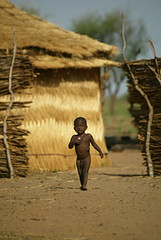 After months of repeated pleas from the United Nations, international aid began in July to pour into this vast arid and semi-arid and landlocked West African nation, ranked by the United Nations to be the second poorest in the world. Niger is now at the biggest impact of last year’s reduced grain, pasture and fodder yields, brought about by the biggest locust invasion of the last 15 years followed by a premature end to the rainy season. Crop and livestock farmers in Maradi, Tillabery, Zinder, and Tahoua – four departments bordering Nigeria in the south – are suffering the most. In villages here, household granaries and fodder stocks are low or empty, cereal prices are skyrocketing (they are now 75-80 percent above the average for the last five years), and livestock prices are plummeting (the cereal purchasing power for livestock-dependent households in agro-pastoral zones is only 25 percent of what it was a year ago).
After months of repeated pleas from the United Nations, international aid began in July to pour into this vast arid and semi-arid and landlocked West African nation, ranked by the United Nations to be the second poorest in the world. Niger is now at the biggest impact of last year’s reduced grain, pasture and fodder yields, brought about by the biggest locust invasion of the last 15 years followed by a premature end to the rainy season. Crop and livestock farmers in Maradi, Tillabery, Zinder, and Tahoua – four departments bordering Nigeria in the south – are suffering the most. In villages here, household granaries and fodder stocks are low or empty, cereal prices are skyrocketing (they are now 75-80 percent above the average for the last five years), and livestock prices are plummeting (the cereal purchasing power for livestock-dependent households in agro-pastoral zones is only 25 percent of what it was a year ago).
Populations have migrated out of the most vulnerable zones and are consuming wild food. One child out of five under the age of five is moderately malnourished and at risk of becoming severely so in the near future if not assisted. Moderate malnutrition is estimated between 13.4 and 19.4 percent, severe malnutrition between 2.4 and 2.9 percent in the most severely affected areas, with rates similar to those of the worst conflict zones and emergencies in the world. As many as 150,000 under 5-year-old children are affected by severe malnutrition among the estimated 800,000 malnourished children nationwide.
Jan Egeland, the UN Emergency Relief Coordinator, told reporters in July that several thousand children had undoubtedly perished this year for lack of food. An April 2005 joint food security assessment by the Niger Government, the Food and Agriculture Organization of the United Nations (FAO), WFP and FEWS NET estimated that 2.4 million of the 3.6 million people living in agropastoral areas were highly vulnerable to food insecurity. Of those, 1.2 million were judged to require some level of food aid. The latest estimate is that 874,000 persons face extreme food insecurity conditions and need free food. This number could grow in the next six weeks as pastoralists return north with their remaining livestock.
Although some press reports indicate that from 150,000 infants to 3.5 million people are threatened by starvation in Niger, FEWS NET argues that there is no basis to expect that starvation is a likely outcome for these numbers of infants or people. ‘Children will likely die from malnourishment but a substantial proportion is probably dying from conditions related to poor water quality, or other non-food related problems.’ FEWS NET reports that although the current food security crisis in Niger is serious, it affects far fewer people than current crises in Ethiopia, Somalia, Zimbabwe and Sudan (Darfur and Northern Bahr El Gazal). The situation in Niger is on par with that found in eastern Chad (in both the refugee camps and among local populations near the camps), and much more severe than those currently found in Mali and Mauritania.
The Hunger Season 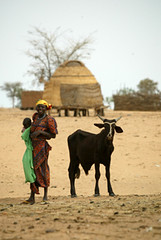 Hunger is an annual event in Niger, where some 82 percent of the population rely on subsistence farming and cattle rearing and only 15 percent of the land is suitable for arable farming. Beyond a little irrigation along the Niger River, most farmers are at the mercy of the rains. Food shortages lasting several months are nothing new. The annual hunger season starts after the millet is planted, at the beginning of the rains in June, and lasts through October, when it’s harvested. Last year’s double whammy of a locust plague followed by poor rains reduced not only millet harvests but also pastures, which feed the country’s livestock, the lifeblood of Niger’s farmers as well as herders. So the hunger season this year has been longer and more intense than normal, putting many people, along with their livelihoods and livestock, over the edge. Niger’s nutritional crisis is likely to deepen still further in the run up to the next harvest. Rural households traditionally help close the annual hunger gap by selling a few animals to buy enough grain to survive until the next millet harvest, in October. This strategy is not working this year. Too many animals are flooding the market, sending livestock prices down, and rising prices for scarce local grain are beyond the reach of poor farmers surviving on less than US$1 a day. Farm households have exported their young men to work as far away as Libya and Algeria and nomads are competing with farmers for scarce resources as they move their herds around looking for fodder. FEWS NET has published the following crisis indicators about the crisis in Niger:
Hunger is an annual event in Niger, where some 82 percent of the population rely on subsistence farming and cattle rearing and only 15 percent of the land is suitable for arable farming. Beyond a little irrigation along the Niger River, most farmers are at the mercy of the rains. Food shortages lasting several months are nothing new. The annual hunger season starts after the millet is planted, at the beginning of the rains in June, and lasts through October, when it’s harvested. Last year’s double whammy of a locust plague followed by poor rains reduced not only millet harvests but also pastures, which feed the country’s livestock, the lifeblood of Niger’s farmers as well as herders. So the hunger season this year has been longer and more intense than normal, putting many people, along with their livelihoods and livestock, over the edge. Niger’s nutritional crisis is likely to deepen still further in the run up to the next harvest. Rural households traditionally help close the annual hunger gap by selling a few animals to buy enough grain to survive until the next millet harvest, in October. This strategy is not working this year. Too many animals are flooding the market, sending livestock prices down, and rising prices for scarce local grain are beyond the reach of poor farmers surviving on less than US$1 a day. Farm households have exported their young men to work as far away as Libya and Algeria and nomads are competing with farmers for scarce resources as they move their herds around looking for fodder. FEWS NET has published the following crisis indicators about the crisis in Niger:
- Unprecedented high food prices.
- Scarcity of local foodstuffs.
- Scarcity of animal feed.
- Collapse of livestock prices.
- Exodus/migration of entire households to neighboring countries in search of new employment.
- Accelerated use of unsustainable survival strategies, liquidation of livestock, household assets and excessive felling of trees in fragile environments.
- Malnutrition rates continue to climb.
The Bad News/Good News
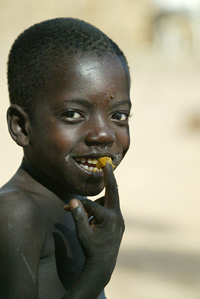 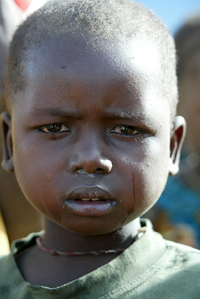
|
The bad news is that in the short-term, malnutrition rates, especially for children, are likely to continue to deteriorate, even if this year’s rains continue to be good. Admissions are rising at therapeutic feeding centres and it is estimated that fewer than one malnourished person in ten makes it to one of the centres. In addition, the rainy season increases the prevalence of malaria and diarrhoeal diseases, which typically increase the risk of severe malnutrition among children. The UN Office for the Coordination of Humanitarian Affairs (OCHA) in July doubled its Niger appeal and warned that it would soon raise it again. Less publicized food crises await to be properly addressed in other countries of the Sahel, the semi-arid strip south of the Sahara desert, such as Mali, Mauritania and Burkina Faso.
The good news is that the current rainy season has gotten off to a very good start in Niger. FEWS NET reports that farmers have been able to plant early; according to the Niger Government’s estimates, 92 percent of the area expected to be under cultivation had been planted by June 15 compared to the 65 percent that is normal for this time of year. The favourable rains are improving pastures, although animal conditions will not rebound immediately. FEWS NET reports that cereal prices in other parts of the Sahel are beginning to fall and those in Niger will likely do the same. Prices for livestock should soon improve with good pasture conditions. The maize harvest is underway in Nigeria, Benin, Ghana, and Ivory Coast, and supplies of imported maize from those countries should soon be arriving in Niger. This will bring lower overall cereal prices.
The national body in Niger in charge of coordinating risk reduction, prevention and response activities to mitigate and manage food crises (Dispositif National de Prévention et de Gestion des Crises Alimentaires – DNPGCA and Cellule Crise Alimentaire of the Prime Minister’s Cabinet – CCA) has so far promoted subsidized sales, cereal banks, food for work and loans of cereals to be reimbursed after the upcoming harvest in October. Since mid-July, the Government has been distributing free food to specific targets in the most critical areas while continuing to subsidize sales in less critical areas. New partners are settling in Niger and/or boosting their capacities: French Red Cross, Spanish Red Cross, Norwegian Red Cross, Qatari Red Crescent, IFRC, Save the Children US, Islamic Relief, Oxfam UK, Concern, Réunir, MSF/Switzerland. Development partners are stretching their ongoing programs to emergency response activities: World Vision, Care, Africare, CRS, Caritas, Oxfam Québec. These Christian, Muslim and secular humanitarian actors are implementing a range of activities in the most affected area of Niger’s southern agro-pastoral zone, where most of the population is concentrated, with the objective to save lives, to protect agricultural production tools/livelihoods and livestock and to promote the 2005 agricultural campaign.
Immediate Needs  FEWS NET recommends the main focus of additional, immediate, assistance be:
FEWS NET recommends the main focus of additional, immediate, assistance be:
- an augmentation of supplemental feeding for children under five;
- additional support for Niger’s free food distributions;
- provision of emergency animal fodder and livestock nutritional supplements;
- assistance with sanitation and potable water (in areas with the highest malnutrition); and
- seeds for second season cropping, especially short cycle beans.
On 4 August, the UN raised its emergency flash appeal to almost $81 million and the WFP reported that if assistance were not provided quickly, it expects to see a massive liquidation of property and livestock with a severe impact on the current agricultural season.
Long-term Needs
Emergency assistance is not enough. More research and development resources should be spent to address Niger’s chronic food insecurity. Observers say projects aiming to address the root cause of the food crisis, which is poverty, are being diverted to support emergency efforts when the situation calls for close links between relief, development and research activities. Only such links will ensure that humanitarian programs do not inhibit longer term research and development efforts from addressing the underlying causes of poverty. Serious analysis shows that hunger can be conquered and at a modest cost compared to the benefits. The case for making agriculture a priority sector for aid to Niger – where agricultural production accounts for 39 percent of GDP – is overwhelming. ‘The least funding so far is for agricultural programmes’, Jan Egeland has said, ‘which I regret because those are the programmes that can get people out of this,’ explaining that people are now slaughtering or selling their cattle used for breeding.
The case for supporting livestock development in Niger – where livestock products make up one of just two main exports and 82 percent of the population practice agro-pastoral subsistence farming – is also overwhelming. ‘The hunger crisis in Niger is difficult to assess because it is “patchy”,’ says Bruno Gerard, an ILRI partner scientist based outside Niamey and working for the last 14 years working for ILRI’s sister institute, the International Crops Research Institute for the Semi-Arid Tropics (ICRISAT). ‘That and other issues that must be addressed to resolve Niger’s chronic food insecurity are largely researchable issues,’ he says. Gerard manages a large project with 10 partners building research-based ‘decision-support systems’ to help farmers improve their marketing, soil fertility and other strategies. ‘This is not a hopeless country’, says Gerard. ‘Traditional options are simply not working well. The real opportunities here are in finding ways to intensify the traditional mixed crop-and-livestock farming systems for greater productivity and sustainability. And that’s just what we’re doing with ILRI and other scientific partners.’
The Livestock Crisis 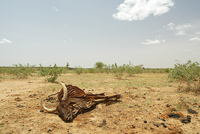 Nomadic herdsmen, whose starving cattle and donkeys have begun dying in large numbers, are at even greater risk than crop farmers. Humanitarian workers reckon it will take them at least two years to rebuild their herds. The limited availability of pasture and of fodder is endangering livestock. Niger’s fodder deficit in pastoral areas in 2004 was 154 percent greater than the 2000 deficit, and at 4.6 tons, the largest fodder deficit in Niger’s history. One-third of this deficit was caused by locusts and two-thirds by the 2004 drought. Fodder remains very expensive. Cows, sheep, goats and camels, which represent the ‘saving accounts’ of agro-pastoralists and pastoralists, are typically meagre and are being sold at dramatically low prices. The monetary value of livestock compared to the equivalent in cereals has decreased between 42 and 55 percent. High cereal prices and falling animal prices in the most affected pastoral and agro-pastoral areas, have led to some households having to liquidate assets in the face of these harsh terms of trade.
Nomadic herdsmen, whose starving cattle and donkeys have begun dying in large numbers, are at even greater risk than crop farmers. Humanitarian workers reckon it will take them at least two years to rebuild their herds. The limited availability of pasture and of fodder is endangering livestock. Niger’s fodder deficit in pastoral areas in 2004 was 154 percent greater than the 2000 deficit, and at 4.6 tons, the largest fodder deficit in Niger’s history. One-third of this deficit was caused by locusts and two-thirds by the 2004 drought. Fodder remains very expensive. Cows, sheep, goats and camels, which represent the ‘saving accounts’ of agro-pastoralists and pastoralists, are typically meagre and are being sold at dramatically low prices. The monetary value of livestock compared to the equivalent in cereals has decreased between 42 and 55 percent. High cereal prices and falling animal prices in the most affected pastoral and agro-pastoral areas, have led to some households having to liquidate assets in the face of these harsh terms of trade.
In worst cases, cows are being sold for US$10. Dakoro, Filingué and Ouallam are the worst affected zones for livestock. Pastoralists and agro-pastoralists began moving their animals south towards the coast earlier than normal to graze on the residue of harvested crops. While this preserves the herds, pastoralist households, especially women and children who normally remain in Niger, will be longer without meat and milk from their animals, and will have to buy more of their food by selling small animals, their assets, or their labor. This also results in larger numbers of males migrating to seek paid labour. This year's return of livestock herds from the south began with the good rains that started in May and June. There have been cases where some herds were temporarily ‘stranded’ between their northern pastures that had yet to regenerate, and the areas they were leaving in order for planting to begin. It is also noted that this year, coping capacities appear to be stretched to the limit by continuing high cereal prices that translate into poor terms of trade in selling livestock to buy cereals.
-Source: FEWS NET
ILRI and Livestock Research in Niger
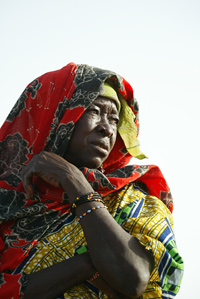
|
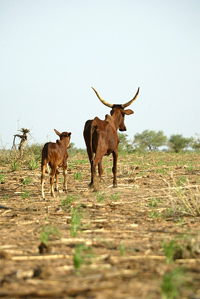
|
ILRI has conducted livestock research for development in Niger for three decades. ILRI’s senior scientists in the country have included (in chronological order) geographer and anthropologist Matt Turner (USA), rangeland ecologist Pierre Hiernaux (France), soil scientist Mark Powell (USA), agricultural economist Tim Williams (Nigeria), animal nutritionist Salvador Fernández-Rivera (Mexico), and livestock systems specialist Augustine Ayantunde (Nigeria), the latter leads ILRI research in Niger today. Among the Nigerian support team that have worked for ILRI over these years are two technicians who have lived and worked for 15 years in ILRI’s two target villages in Fakara, an area between the Niger Valley and the Dallol Bosso, one hundred km east of Niger’s capital, Niamey. ILRI work in Fakara covers a region of over 500 sq km. Most of the images in this photo essay were obtained in Fakara in June 2005, one month before the country's hunger problem began to make news.
ILRI’s long-term focus in Niger is finding improved ways to integrate livestock keeping into crop farming systems to improve the Sahel’s fragile lands as well as the livelihoods of its peoples. ILRI (www.ilri.org) has conducted much of its research in Niger under the aegis of two systemwide programs of the Consultative Group on International Agricultural Research (www.cgiar.org), which sponsors the research of ILRI and 14 other centres working to alleviate poverty in the developing world: the ILRI-convened Systemwide Livestock Programme (www.vslp.org/vslp/front_content.php) and the ICRISAT-convened Desert Margins Program (www.icrisat.org/text/partnerships/dmp/dmp.htm). In these and other projects, ILRI focuses on livestock aspects and ICRISAT on food and feed crops which, taken together, can refine the integration of crop and livestock production with triple-bottom-line benefits for people (more food), livestock (more feed) and soils (more nutrients).
ILRI’s Niger team recently conducted a project funded by USAID investigating how to improve markets for small-scale peri-urban farmers producing milk and fattening sheep (for Muslim holidays) and collaborated with America’s Wisconsin University on research to help manage conflicts between crop and livestock producers. In the scorching hot and resource-challenged Sahelian environments, where transhumance is practised as it has been for millennia, and where millet and livestock mean life and livelihood to most of the population, conflicts over increasingly scarce water and land resources are increasing.
Livestock Relief 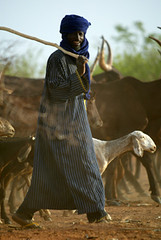 FAO renewed on 2 August its appeal for $4 million urgently needed for veterinary services and to feed livestock, which play a key role in the livelihoods and food security of many of the most vulnerable households. ‘Livestock are crucial to agro-pastoralist families in Niger, for income as well as food,’ the Chief of FAO’s Emergency Operations Service, Fernanda Guerrieri, said. ‘The sale of livestock is often a measure of last resort, after families have already consumed all of their cereal stocks and require cash to buy food for the lean period before the next harvest. A loss of livestock or decrease in their market value can have a devastating impact on these families’ food security,’ she added. Livestock aid is needed for more than 10,000 families who have lost their animals. Without this assistance, the crisis could worsen and more food aid would be needed. The funds will be used to provide veterinary services and feed for more than 10,000 families facing severe hunger due to livestock losses.
FAO renewed on 2 August its appeal for $4 million urgently needed for veterinary services and to feed livestock, which play a key role in the livelihoods and food security of many of the most vulnerable households. ‘Livestock are crucial to agro-pastoralist families in Niger, for income as well as food,’ the Chief of FAO’s Emergency Operations Service, Fernanda Guerrieri, said. ‘The sale of livestock is often a measure of last resort, after families have already consumed all of their cereal stocks and require cash to buy food for the lean period before the next harvest. A loss of livestock or decrease in their market value can have a devastating impact on these families’ food security,’ she added. Livestock aid is needed for more than 10,000 families who have lost their animals. Without this assistance, the crisis could worsen and more food aid would be needed. The funds will be used to provide veterinary services and feed for more than 10,000 families facing severe hunger due to livestock losses. 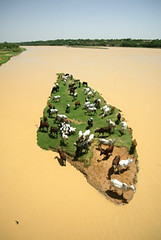
Oxfam is helping 28,000 people by buying, for a fair price, cattle too emaciated for herders to sell. Cattle prices have been plummeting and are now 90 percent lower than they were before the crisis. Even healthy animals are fetching only a fraction of their former value. A strong bull that once went for more than $500 now sells for as little as $18. ‘Oxfam’s response is stimulating the economy by trying to use local markets,’ said Mike Delaney, Oxfam America’s director of humanitarian response. Another voucher-for-work project is linked to the cattle-buying program. Oxfam has already purchased 1,000 cows from local breeders for about $53 a head, providing people with money to feed both their families and their remaining animals. Oxfam then has the cows slaughtered in the villages and inspected by veterinarians to make sure the meat is fit for consumption. Women involved in the voucher-for-work program dry or fry the meat. Oxfam gives some of the meat to them in exchange for their work, or distributes it through the rest of the voucher program.
Bitter Ironies 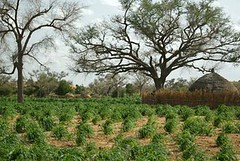 Newcomers heading into Niger’s countryside find it surprisingly green. Aside from pockets of dusty scrub, healthy young foot-tall millet crops appear from one horizon to the other. Herein lies a bitter paradox. The rainy season, which gets into full swing in August, actually started well this year, in June. But this does nothing to fill the so-called hunger gap between the June planting and October harvesting. Crops may be growing, but they are of no use to anyone for another two months. New grass sprouting from sandy rangelands is just as useless to the ubiquitous herds of cattle and donkeys, for many of which the young shoots are too little too late; the animals lie down on the new green pastures and don’t get up again. Things appear deceptively fine even in the mud hut villages – where the women pound millet and the children run and play – until one takes a closer look or pays a visit to the women’s huts where the ‘silent hunger’, as its being called, has struck young children, making them too weak or ill to cry.
Newcomers heading into Niger’s countryside find it surprisingly green. Aside from pockets of dusty scrub, healthy young foot-tall millet crops appear from one horizon to the other. Herein lies a bitter paradox. The rainy season, which gets into full swing in August, actually started well this year, in June. But this does nothing to fill the so-called hunger gap between the June planting and October harvesting. Crops may be growing, but they are of no use to anyone for another two months. New grass sprouting from sandy rangelands is just as useless to the ubiquitous herds of cattle and donkeys, for many of which the young shoots are too little too late; the animals lie down on the new green pastures and don’t get up again. Things appear deceptively fine even in the mud hut villages – where the women pound millet and the children run and play – until one takes a closer look or pays a visit to the women’s huts where the ‘silent hunger’, as its being called, has struck young children, making them too weak or ill to cry.
Many villagers say they can’t afford to leave their families to take a famished child to the nearest feeding centre. They are busy ploughing and preparing their land for the next crop that will feed their household for the coming year. Even when sick, many people won’t come for treatment because they’re frightened to leave the young crops that they’re trying to nurse into life. It is a deathly bind. Top United Nations aid official Jan Egeland and aid officials have accused the international community of reacting slowly to the crisis in Niger, which was widely predicted after last year's poor harvests, and further say the slow response has greatly increased the cost of dealing with the crisis. When the first appeal was made, only $1 per day, per person would have helped solve the food crisis, the U.N. has said. Now that the situation has worsened and people are weaker, $80 will be needed per person. One reason for the delay in international response was that other events were crowding out news about the hunger in major media.
Following the worst turmoil in Darfur and the tsunami in Southeast Asia, ironically it was the G8 summit in Gleneagles, Scotland, in June, with the rock-star Live8 concerts and ‘Make Poverty History’ campaigns that attended it, that helped push the Niger crisis off world headlines. While the G8 was noisily canceling the debts of Niger and 13 other African countries, this club of the world’s most powerful nations failed to notice or even mention Niger’s hunger crisis.
The Cereal Crisis 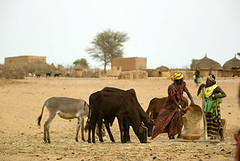 As local cereals (millet, sorghum) have become scarce items on the market in Niger and the subregion as well as subject to speculation, prices have doubled over normal. Most warehouses are empty. Assessments undertaken by CILSS (the regional inter-governmental body responsible for Sahelian food security) found that unusually high prices for millet and sorghum in neighboring markets in Nigeria, Ghana, Benin and Ivory Coast have been drawing Sahelian grain to the south during the last few months. Outflow from Niger has been significant and a major factor in driving up prices in the agro-pastoral and pastoral zones of Niger where purchasing power is the weakest. In most years, Niger imports cereals from surplus-producing areas of its neighbors in Nigeria, Burkina Faso, and Mali. However, this year, each of these three countries imposed restrictions of exports, due to fears of famine and grain shortages, despite trade treaties that forbid that. CILSS has cautioned that overstatements of the severity of Sahelian food crises by the media, international agencies, and NGOs have had the unintended consequence of causing private traders to withhold stocks from the market, in anticipation of higher prices, or of local purchases by aid agencies, further pushing up cereal prices.
As local cereals (millet, sorghum) have become scarce items on the market in Niger and the subregion as well as subject to speculation, prices have doubled over normal. Most warehouses are empty. Assessments undertaken by CILSS (the regional inter-governmental body responsible for Sahelian food security) found that unusually high prices for millet and sorghum in neighboring markets in Nigeria, Ghana, Benin and Ivory Coast have been drawing Sahelian grain to the south during the last few months. Outflow from Niger has been significant and a major factor in driving up prices in the agro-pastoral and pastoral zones of Niger where purchasing power is the weakest. In most years, Niger imports cereals from surplus-producing areas of its neighbors in Nigeria, Burkina Faso, and Mali. However, this year, each of these three countries imposed restrictions of exports, due to fears of famine and grain shortages, despite trade treaties that forbid that. CILSS has cautioned that overstatements of the severity of Sahelian food crises by the media, international agencies, and NGOs have had the unintended consequence of causing private traders to withhold stocks from the market, in anticipation of higher prices, or of local purchases by aid agencies, further pushing up cereal prices.
These issues merit further study.  West African grain markets are generally working very well, perhaps too well. The high cereal price levels found in the Sahel are being driven by strong demand for Sahelian cereal production, and greater purchasing power in coastal West African countries. Markets in the most food-insecure zones in the Sahel (and in Niger) usually have higher cereal prices than elsewhere, due to the high costs of transporting grain to these sparsely-populated and poor areas. Although their governments are committed to open markets, high costs and infrastructure limitations do not allow Sahelian markets to efficiently collect surpluses, anticipate local and regional demand conditions, and supply foods to poor households at affordable prices. Source: FEWS NET
West African grain markets are generally working very well, perhaps too well. The high cereal price levels found in the Sahel are being driven by strong demand for Sahelian cereal production, and greater purchasing power in coastal West African countries. Markets in the most food-insecure zones in the Sahel (and in Niger) usually have higher cereal prices than elsewhere, due to the high costs of transporting grain to these sparsely-populated and poor areas. Although their governments are committed to open markets, high costs and infrastructure limitations do not allow Sahelian markets to efficiently collect surpluses, anticipate local and regional demand conditions, and supply foods to poor households at affordable prices. Source: FEWS NET
ILRI, Livestock and the Millennium Development Goals 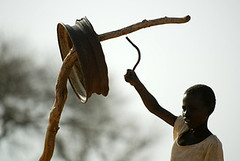 The international community is laying the groundwork for a new, coherent and eminently feasible attack on global poverty. The focus of this effort is the Millennium Development Goals (MDG) – eight commitments drawn from the Millennium Declaration, endorsed by all member states of the United Nations in September 2000. Ranging from halving extreme poverty to halting the spread of HIV/AIDS and providing universal primary education – all by the target date of 2015 – they represent a set of simple but powerful objectives that every man and woman in the street, from New York to Nairobi to New Delhi, can easily understand and support. . . . The MDG are people-centred, time-bound and measurable. . . . Now we have a set of clear, measurable indicators, focused on basic human needs, that can provide clear benchmarks of progress – or the lack of it – both globally and on a country-by-country basis. . . . Never before have such concrete goals been formally endorsed by rich and poor countries alike. And never before have the UN, the World Bank, the International Monetary Fund and all the other principal arms of the international system come together behind the same set of development objectives. . . . And the MDG are achievable. – Source: Kofi Annan, Economist: The World in 2003
The international community is laying the groundwork for a new, coherent and eminently feasible attack on global poverty. The focus of this effort is the Millennium Development Goals (MDG) – eight commitments drawn from the Millennium Declaration, endorsed by all member states of the United Nations in September 2000. Ranging from halving extreme poverty to halting the spread of HIV/AIDS and providing universal primary education – all by the target date of 2015 – they represent a set of simple but powerful objectives that every man and woman in the street, from New York to Nairobi to New Delhi, can easily understand and support. . . . The MDG are people-centred, time-bound and measurable. . . . Now we have a set of clear, measurable indicators, focused on basic human needs, that can provide clear benchmarks of progress – or the lack of it – both globally and on a country-by-country basis. . . . Never before have such concrete goals been formally endorsed by rich and poor countries alike. And never before have the UN, the World Bank, the International Monetary Fund and all the other principal arms of the international system come together behind the same set of development objectives. . . . And the MDG are achievable. – Source: Kofi Annan, Economist: The World in 2003
The knowledge and technologies generated by ILRI and its many partners in the North and South that are conducting livestock research for development are helping to meet the United Nations Millennium Development Goals. ILRI is a non-profit-making and non-governmental organization working at the crossroads of livestock and poverty. ILRI has its headquarters in Nairobi, Kenya, and a second principal campus in Addis Ababa, Ethiopia. The Institute belongs to the Consultative Group on International Agricultural Research (CGIAR). This association of more than 60 governments and organizations supports a network of 15 Future Harvest agricultural research centres working to reduce poverty, hunger and environmental degradation in developing countries. The co-sponsors of the CGIAR are the World Bank, the UNDP, FAO and the International Fund for Agricultural Development.

